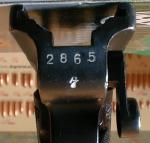 |
This is a post war East German rework of a World War II Luger chamber dated 1936,
coded S/42. East Germany reworked Lugers for issuance to the East German police,
to be used as foreign military aid to Warsaw Pact surrogate forces, and for commercial
sale. Parts were replaced as needed, and the new parts were numbered to the frame
serial number. If the ìnewî part already had a number (as parts from
salvaged Lugers would), the original number was removed and the new number stamped
in the correct location. In later reworks the original part number was frequently
struck out and the new number stamped closely to the old, superceded, number. Lugers
reworked for internal issue or foreign military aid were generally hot salt reblued
without much in the way of surface preparation yielding a dull or flat final finish.
Luger reworked specifically for commercial sale were frequently highly polished before
they were hot salt blued, and will have a very fine finish. On this specific Luger,
note the brown plastic grip with the concentric circle molded into it. This is one
of the identifying characteristics of an East German rework. Also note that this
is a military, or flat, refinish. On 1936 dated Lugers the original finish called
for straw on trigger, safety, and take down latch - those on this pistol are blued. |
 |
Close up of S/42, 1936 dated cannon. |
 |
Close up of left side markings. Note number on the take down latch. While the number
matches the frame serial number (as do all numbers on this Luger), it is of a different
size than all the other numbers. The East Germans have replaced the take down latch
on this pistol during their rework. Note that while the "65" matches the
serial number of the pistol and is correctly placed, it is of the wrong size. Parts
that appear to match but have wrong style or sized numbers are common on East German
reworks. Also note the "X" on the left of the cannon serial number. This
marking is found on some East German reworks and not on others. Its meaning and purpose
are not known, and it has been suggested it may be a destruction mark. A very similar
mark is found on most of the German Kar98K rifles captured by Soviet Russia and recently
sold on the surplus market. Whether the similar marks on East German and Soviet Russian
reworked arms are related is unknown at present. |
 |
Right side of barrel extension. Note two Eagle over "63" inspection marks,
and the droop wing firing proof on the barrel extension and barrel. Also note the
firing proof is rotated 90 degrees clockwise from vertical - this changes to vertical
on the 1937 dated Lugers. |
 |
Bottom of 1936 frame. Note the lower case letter "g" below the serial number,
indicating this pistol is from the "g" serial number block ("1 g"
- "9999 g") of the 1936 production. |
 |
Bottom of 1936 barrel. Note serial number and barrel gauge. Witness mark on barrel
and barrel extension is also visible. |
 |
Many (if not all) of the East German reworks will have replacement, post-war, magazines.
These are generally noted to be stamped ì2/1001î on the magazine body
- the magazine of this pistol is an example. |
| Photos Courtesy of Kyrie |